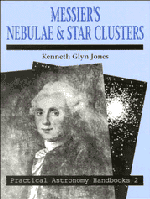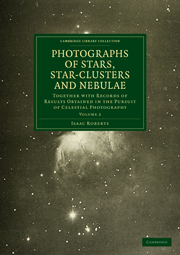Observing and Cataloguing Nebulae and Star Clusters
The New General Catalogue, originally created in 1888, is the source for referencing bright nebulae and star clusters, both in professional and amateur astronomy. With 7840 entries, it is the most-used historical catalogue of observational astronomy, and NGC numbers are commonly used today. However, the fascinating history of the discovery, observation, description and cataloguing of nebulae and star clusters in the nineteenth century has largely gone untold, until now. This well-researched book is the first comprehensive historical study of the NGC, and is an important resource to all those with an interest in the history of modern astronomy and visual deep-sky observing. It covers the people, observatories, instruments and methods involved in nineteenth century visual deep-sky observing, as well as prominent deep-sky objects. The book also compares the NGC to modern object data, demonstrating how important the NGC is in observational astronomy today.
- A unique source for visual observers and professional astronomers, providing an extensive study of the New General Catalogue (NGC)
- Presents a complete overview of nineteenth-century visual deep-sky observations and the history of eminent deep-sky objects
- Highlights the importance of the NGC in modern observational astronomy
Reviews & endorsements
"Historians remember the distinction E.H. Carr drew a generation ago, between mere 'facts'--statements that are true--and 'historical facts'--facts that historians use to shed light on the historical process. This book is replete with 'facts', and historians now have these at their disposal; and so some of these 'facts' will in due course be promoted to become 'historical facts'. It is wonderful to have such a treasure trove available, and Cambridge University Press must be congratulated for undertaking the publication of such a demanding work." Michael Hoskin, Journal for the History of Astronomy
"...anyone who considers themselves to be an ardent deep-sky enthusiast this book is a must. The illustrations (375) alone make this work a remarkable addition to anyone's library, showing each of the contributing astronomers to the NGC, and many of the telescopes they used to make their discoveries, many being photographs that I have never seen published before. Yes, I am very excited about this book. Not only does it contain a wealth of information of scientific significance, but because of its scope it also reads often as an adventure story and in many respects that is exactly what the study of this fabulous field contains. ... I can assure you that you won't be disappointed." Malcom J. Thomas, FRAS, Deep Sky Observer
"The book is a must for anyone interested in the history of deep sky observing and Cambridge University Press are to be congratulated in publishing what may appear to be a very niche publication. The book does contain a number of appendices and a vast bibliography for readers wishing to delve deeper. The book itself is a snapshot in time as Wolfgang does keep a website at http://www.klima-luft.de/steinicke/steuer/start_e.htm which keeps the story updated along with more biographical information and images of the discoverers of the objects in the NGC and IC." Owen Brazell, Astronomy Now Online
"The coverage of Steinicke's book is remarkable for both its breadth and depth. We read not only of the great figures whose discoveries became part of the NGC, such as the Herschels and Lord Rosse, but also of many lesser-known observers who did important work. There is also detailed treatment of the arguments that raged as to the nature of the nebulae − were they gaseous objects or unresolved star clusters? − and on the reality of some nebulae and the features within them. There are extensive references, not only to the writings of the nineteenth-century astronomers themselves, but also to secondary sources by modern science historians. Steinicke's text is backed up by extensive − some would say exhaustive − tables giving statistics on the objects covered, as well as many illustrations. With more than 600 pages and a small typeface, this is not a book for use at the telescope, nor one to be read from cover to cover. Rather, it is an essential reference work for the serious deep-sky observer or historian. It is also a delightful book to dip into on cloudy evenings, as it abounds with compact biographies of many of the astronomers, complete with their portraits. ... I heartily recommend it to all serious deep-sky observers and historians of astronomy." Lee Macdonald, Journal of the British Astronomical Association
"With 359 figures, among them many portraits of nowadays little-known astronomers and contemporary sketches of objects, 238 tables and 1628 references, this will remain the standard reference work in the field. With this labour of love, Steinicke has provided an invaluable service to historians of astronomy and deep sky observers." Professor Hilmar W. Duerbeck, Centre for Astronomy, James Cook University, Journal of Astronomical History and Heritage
"The book is not an easy read and it can be a little dry and academic on occasion but overall, the execution is superb and Mr. Steineicke should be congratulated for being able to pull it off. For amateur astronomers interested in the history of astronomy, this is a must-have." alibris.com
"No stone has been left unturned in the quest for detail in this exhaustively researched, comprehensive history of the compilation of the New General Catalogue (NGC)." Sky at Night Magazine
"...a sturdy, hardcore package for an observer who loves the history of astronomy. I personally rate this book as one of the very best in my fairly large astronomy library and trust me when I say I'm not an easy guy to please. Recommended for history enthusiasts, worth browsing for regular observers." Jaakko Saloranta (http://fdsa-blog.blogspot.com/2010/09/observing-and-cataloguing-nebulae-and.html)
Product details
September 2010Adobe eBook Reader
9780511784354
0 pages
0kg
357 b/w illus. 238 tables
This ISBN is for an eBook version which is distributed on our behalf by a third party.
Table of Contents
- Preface
- 1. Introduction
- 2. William Herschel's observations and parallel activities
- 3. John Herschel's Slough observations
- 4. Discoveries made in parallel with John Herschel's Slough
- 5. John Herschel at the Cape of Good Hope
- 6. The time after Herschel's observations till Auwers' list of new nebulae
- 7. Compiling the General Catalogue
- 8. Dreyer's first catalogue: the supplement to Herschel's General Catalogue
- 9. Compilation of the New General Catalogue 356
- 10. The New General Catalogue: publication, analysis and effects
- 11. Special topics
- 12. Summary
- Appendices
- Index.





